Numerical Investigations for the Two-Phase Flow Structures and Chemical Reactions within a Tray Flue Gas Desulfurization Tower by Porous Media Model
Abstract
:1. Introduction
2. Computational Models
2.1. Eulerian–Eulerian Two-Phase Flow Model
2.2. Chemical Mechanisms
- Step 1:
- Solve the Eulerian–Eulerian two-phase flow models from Equations (1) to (5) at the current time step, while the chemical source term S in Equation (14) is obtained from the previous time step.
- Step 2:
- Obtain ClSlurry from Equation (12) and CgSO2 from Equation (13) according to the flow variables of the current time step.
- Step 3:
- Input ClSlurry from Equation (12) into a prepared chemical database by UDF. This database is written in Matlab to solve the sets from Equations (8) to (10). With ClSlurry given from flow solver, this chemical database can solve the remaining unknowns and then output the value of ClSO2 to the flow solver.
- Step 4:
- Insert CgSO2 from step 2 and ClSO2 from step 3 into Equation (14) to calculate a new chemical source term S for the next time step.
- Step 5:
- Update the time step and repeat step 1 to 4 if necessary.
2.3. Porous Media Model
3. Validations of the Two-Phase and Porous Media Model
3.1. Geometries of the Small- and Full-Scale FGD
3.2. Geometries of the Perforated Sieve Trays of the Small- and Full-Scale FGD
3.3. Working Conditions of the Small- and Full-Scale FGD
3.4. Boundary Conditions, Grid Layouts, and Validations for the Small-Scale Tower
3.5. Comparisons between Numerical Results by Perforated Structures and Porous Media Model in a Small-Scale Tower
3.6. Numerical Results by Porous Media Model in a Large-Scale Tower
4. Designs of the Small-Scale Tower from Numerical Experiments
4.1. Comparisons between Four-Tray and Empty Tower (Case A and Case C)
4.2. Comparisons between Empty and One-Tray Tower (Case C and Case D)
4.3. Comparisons between Different Inlet Gas Flow Rates (Case E–Case G)
5. Conclusions
- The complex structures of sieve trays are replaced by the porous media model, which significantly saves the computational time with consistent results with those simulated by detailed perforated structures and measured data in a small-scale FGD tower. As for the full-scale tower, the computational cost with detailed structure is too expansive considering the enormous scale ratio between the perforated hole at the sieve tray and radius of tower. The porous media model makes the simulations of full-scale tower more practical and was validated in the experiments, which further proves the feasibility of using a porous media model.
- The liquid column from the nozzle experiences deceleration near the top surface of sieve tray and acceleration within it. As the liquid flow has not reached its terminal velocity, the acceleration remains even the liquid passes the tray region. The deceleration leads to the accumulation of liquid volume fraction near the sieve tray, while the acceleration reduces the size of liquid column because of continuity. These mechanisms result in the reduction of liquid column between two neighboring sieve trays and affect the two-phase mixing within the FGD tower.
- The empty, one-tray, and four-tray towers were simulated at different flow conditions. The size of liquid column with better two-phase mixing in the center and the area of uprising gas near the wall play the most important roles to determine the desulfurization performance. At different flow conditions, such as the variation of inlet gas flow rate, these two competing effects end up with different results, which also affects the selections of tray setups.
- The four-tray tower has the best two-phase mixing. However, its liquid column is the smallest, which also ensues the largest area of uprising gas near the wall with higher SO2 concentration. As a result, the four-tray tower at a lower gas flow rate fails to improve the SO2 removal efficiency from the other two tray setups at a lower gas flow rate.
- For a higher inlet gas volume flow rate, the stronger inertial of uprising gas flow leads to a weaker acceleration of the liquid column, and hence, the reduction in size of the liquid column is gentler. Correspondingly, implementing four sieve trays is more efficient under a higher gas volume flow rate. It enhances the performance by 15% from empty tower and 5% from one-tray tower.
- Section 4.2 and Section 4.3 indicate that the sieve tray can enhance two-phase mixing within the liquid column, but it also increases the region of uprising gas where the SO2 mass fraction is higher. Depending on different values of the gas volume flow rate Q, these two competing effects end up with different trends for SO2 removal efficiency.
Author Contributions
Funding
Institutional Review Board Statement
Informed Consent Statement
Data Availability Statement
Acknowledgments
Conflicts of Interest
Nomenclatures
| Symbol | |
| Aint | Interfacial contact area per unit volume |
| Cqp | Molar concentration of species p in q phase |
| Cq,i | Inertial loss coefficient of phase q in i direction |
| Cd | Drag coefficient |
| Dh | Hole diameter |
| dl | Liquid droplet diameters |
| ESO2 | Enhancement factor for SO2 |
| f | Drag function |
| fh | Porosity |
| G | Gravity |
| HSO2 | Henry’s law constant for SO2 |
| Ki | Exchange coefficient in momentum equations |
| K1,K2,K3 | Equilibrium constants |
| KgSO2, KlSO2 | Mass transfer coefficients for SO2 in the gas and liquid phases |
| k | Turbulence kinetic energy |
| M | Momentum sink term for porous media model |
| P | Pressure |
| Reh | Hole Reynolds number |
| Rer | Relative Reynolds number |
| S | Chemical source term |
| t | Time |
| th | Thickness of the porous media region |
| u | Velocity |
| W | Molecular weight |
| xi | i direction |
| Y | Mass fraction |
| Greek symbols | |
| α | Volume fraction |
| τ | Laminar stress |
| τR | Reynolds stress |
| τr | Relaxation time |
| μ | Mixture viscosity |
| ε | Turbulent dissipation rate |
| ρ | Density |
| ξ1, ξ2, ξ3, ξ4, λ | Tabulated coefficients for the porous media model |
| Subscripts | |
| g | gas phase |
| i, j | Direction |
| l | liquid phase |
| M | Mg(OH)2 solution |
| Slurry | Liquid slurry |
References
- Gao, X.; Huo, W.; Luo, Z.-Y.; Cen, K.-F. CFD simulation with enhancement factor of sulfur dioxide absorption in the spray scrubber. J. Zhejiang Univ. A 2008, 9, 1601–1613. [Google Scholar] [CrossRef]
- Nygaard, H.G.; Kiil, S.; Johnsson, J.E.; Jensen, J.N.; Hansen, J.; Fogh, F.; Dam-Johansen, K. Full-scale measurements of SO2 gas phase concentrations and slurry compositions in a wet flue gas desulphurisation spray absorber. Fuel 2004, 83, 1151–1164. [Google Scholar] [CrossRef]
- Sai, J.; Wu, S.; Xu, R.; Sun, R.; Zhao, Y.; Qin, Y. Mass transfer and reaction process of the wet desulfurization reactor with falling film by cross-flow scrubbing. Korean J. Chem. Eng. 2007, 24, 481–488. [Google Scholar] [CrossRef]
- Tseng, C.-C.; Li, C.-J. Numerical investigation of the inertial loss coefficient and the porous media model for the flow through the perforated sieve tray. Chem. Eng. Res. Des. 2016, 106, 126–140. [Google Scholar] [CrossRef]
- Tseng, C.-C.; Li, C.-J. Eulerian-Eulerian numerical simulation for a flue gas desulfurization tower with perforated sieve trays. Int. J. Heat Mass Transf. 2018, 116, 329–345. [Google Scholar] [CrossRef]
- Brogren, C.; Hakansson, R.; Benton, K.; Rader, P. Performance enhancement plates (PEP): Up to 20 percent reduction in power consumption of wfgd. In Proceedings of the Combined power plant pollutant control mega symposium, Atlanta, GA, USA, 16–20 August 1999. [Google Scholar]
- Dopatka, J.; Ford, N.; Jiajanpong, K. Opportunities to achieve improved WFGD performance and economics. In Proceedings of the Combined Power Plant Control Mega Symposium 2003, Washington, DC, USA, 19–22 May 2003. [Google Scholar]
- Zhu, J.; Zhao, P.; Yang, S.; Chen, L.; Zhang, Q.; Yan, Q. Continuous SO2 absorption and desorption in regenerable flue gas desulfurization with ethylenediamine-phosphoric acid solution: A rate-based dynamic modeling. Fuel 2021, 292, 120263. [Google Scholar] [CrossRef]
- Marocco, L.; Inzoli, F. Multiphase Euler–Lagrange CFD simulation applied to wet flue gas desulphurisation technology. Int. J. Multiph. Flow 2009, 35, 185–194. [Google Scholar] [CrossRef]
- Gómez, A.; Fueyo, N.; Tomás, A. Detailed modelling of a flue-gas desulfurisation plant. Comput. Chem. Eng. 2007, 31, 1419–1431. [Google Scholar] [CrossRef]
- Qu, J.; Qi, N.; Li, Z.; Zhang, K.; Wang, P.; Li, L. Mass transfer process intensification for SO2 absorption in a commercial-scale wet flue gas desulfurization scrubber. Chem. Eng. Process. Process Intensif. 2021, 166, 108478. [Google Scholar] [CrossRef]
- Qu, J.; Qi, N.; Zhang, K.; Li, L.; Wang, P. Wet flue gas desulfurization performance of 330 MW coal-fired power unit based on computational fluid dynamics region identification of flow pattern and transfer process. Chin. J. Chem. Eng. 2021, 29, 13–26. [Google Scholar] [CrossRef]
- Xu, Y.; Chen, X.; Zhao, Y.; Jin, B. Modeling and analysis of CO2 capture by aqueous ammonia + piperazine blended solution in a spray column. Sep. Purif. Technol. 2021, 267, 118655. [Google Scholar] [CrossRef]
- Deng, Q.; Ran, J.; Niu, J.; Yang, Z.; Pu, G.; Yang, L. Numerical Study on Flow Field Distribution Regularities in Wet Gas Desulfurization Tower Changing Inlet Gas/Liquid Feature Parameters. J. Energy Resour. Technol. 2020, 143, 023005. [Google Scholar] [CrossRef]
- Du, J.; Hui, Z.; Wu, F.; Yan, Y.; Yue, K.; Ma, X. CFD Analysis of a Water Vaporization Process in a Three-Dimensional Spouted Bed for Flue Gas Desulfurization. ACS Omega 2021, 6, 2759–2766. [Google Scholar] [CrossRef] [PubMed]
- Wu, F.; Bai, J.; Yue, K.; Gong, M.; Ma, X.; Zhou, W. Eulerian-Eulerian Numerical Study of the Flue Gas Desulfurization Process in a Semidry Spouted Bed Reactor. ACS Omega 2020, 5, 3282–3293. [Google Scholar] [CrossRef]
- Jamshidifard, S.; Shirvani, M.; Kasiri, N.; Movahedirad, S. Fine particle removal from gas stream using a helical-duct dust concentrator: Numerical study. Chem. Eng. Process. Process Intensif. 2019, 143, 107516. [Google Scholar] [CrossRef]
- Chou, Y.-J.; Shao, Y.-C. Numerical study of particle-induced Rayleigh-Taylor instability: Effects of particle settling and entrainment. Phys. Fluids 2016, 28, 043302. [Google Scholar] [CrossRef]
- Sun, Y.; Guan, Z.; Gurgenci, H.; Hooman, K.; Li, X.; Xia, L. Investigation on the influence of injection direction on the spray cooling performance in natural draft dry cooling tower. Int. J. Heat Mass Transf. 2017, 110, 113–131. [Google Scholar] [CrossRef]
- Crowe, C.T.; Sharma, M.P.; Stock, D.E. The Particle-Source-In Cell (PSI-CELL) Model for Gas-Droplet Flows. J. Fluids Eng. 1977, 99, 325–332. [Google Scholar] [CrossRef]
- Benyahia, S.; Galvin, J.E. Estimation of numerical errors related to some basic assumptions in discrete particle methods. Ind. Eng. Chem. Res. 2010, 49, 10588–10605. [Google Scholar] [CrossRef] [Green Version]
- ANSYS Fluent. ANSYS Fluent 12.0 User’s Guide; Ansys Inc.: Canonsburg, PA, USA, 2009; Volume 15317, pp. 1–2498. [Google Scholar]
- Choi, M.; Lim, Y.; Lee, H.; Jung, H.; Lee, J. Flow uniformizing distribution panel design based on a non-uniform porosity distribution. J. Wind Eng. Ind. Aerodyn. 2014, 130, 41–47. [Google Scholar] [CrossRef]
- Chen, Z.; Wang, H.; Zhuo, J.; You, C. Experimental and numerical study on effects of deflectors on flow field distribution and desulfurization efficiency in spray towers. Fuel Process. Technol. 2017, 162, 1–12. [Google Scholar] [CrossRef]
- Guo, B.; Hou, Q.; Yu, A.; Li, L.; Guo, J. Numerical modelling of the gas flow through perforated plates. Chem. Eng. Res. Des. 2013, 91, 403–408. [Google Scholar] [CrossRef]
- Ergun, S. Fluid flow through packed columns. Chem. Eng. Prog. 1952, 48, 89–94. [Google Scholar]
- Jackson, G.W.; James, D.F. The permeability of fibrous porous media. Can. J. Chem. Eng. 1986, 64, 364–374. [Google Scholar] [CrossRef]
- Idelchik, I.E. Handbook of Hydraulic Resistance, 3rd ed.; Begell Houss: Danbury, CT, USA, 1996. [Google Scholar]
- Wenbin, L.; Botan, L.; Guocong, Y.; Xigang, Y. A new model for the simulation of distillation column. Chin. J. Chem. Eng. 2011, 19, 717–725. [Google Scholar]
- Shyy, W.; Thakur, S.S.; Ouyang, H.; Liu, J.; Blosch, E. Computational Techniques for Complex Transport Phenomena; Cambridge University Press: Cambridge, UK, 1997. [Google Scholar]
- Launder, B.; Spalding, D. The numerical computation of turbulent flows. Comput. Methods Appl. Mech. Eng. 1974, 3, 269–289. [Google Scholar] [CrossRef]
- Schiller, L.; Naumann, A. A drag coefficient correlation. Zeit. Ver. Deutsch. Ing. 1933, 77, 318–320. [Google Scholar]
- Harris, D.C. Quantitative Chemical Analysis; Macmillan: New York, NY, USA, 2010. [Google Scholar]
- China Steel Cooperation. 2021. Available online: http://www.csmc.com.tw/csr06_ch.aspx (accessed on 31 December 2021).
- Patankar, S.V. Numerical Heat Transfer and Fluid Flow; Hemisphere: Washington, DC, USA, 1980. [Google Scholar]
- Huang, Y.S.; Tseng, C.C.; Chien, C.C. Numerical Simulation of the Flue Gas Desulfurization in the Sieve Tray Tower. China Steel Rep. 2015, 28, 52–57. [Google Scholar]
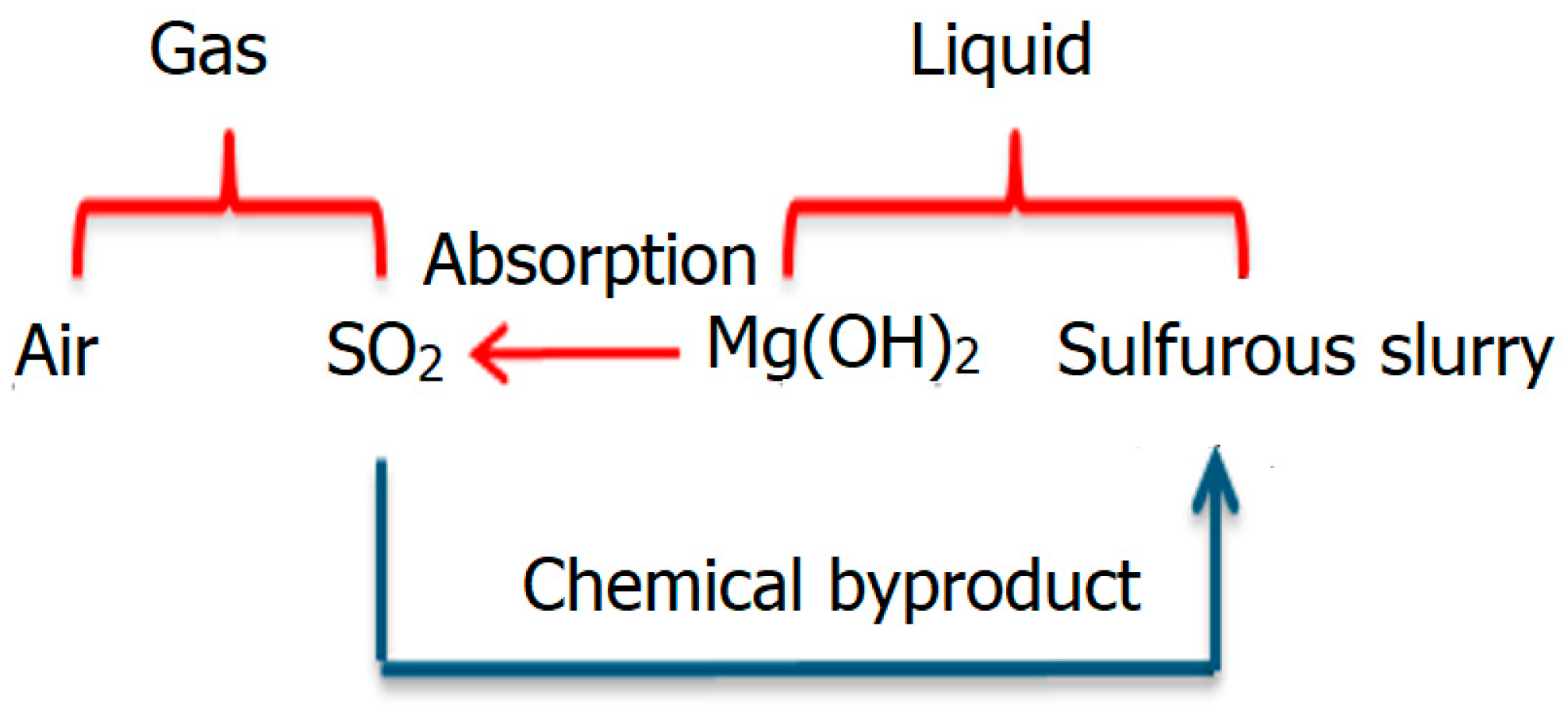
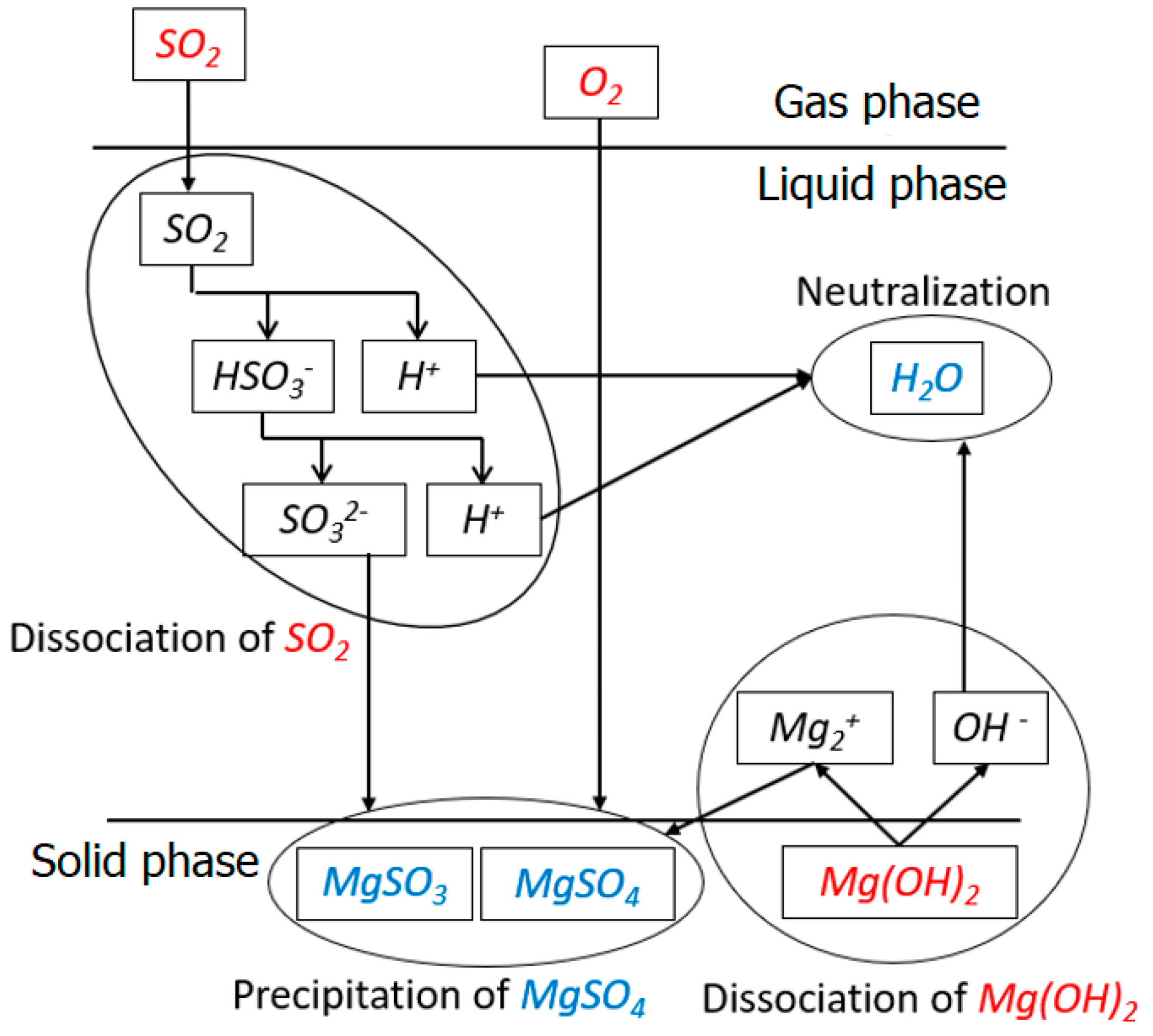

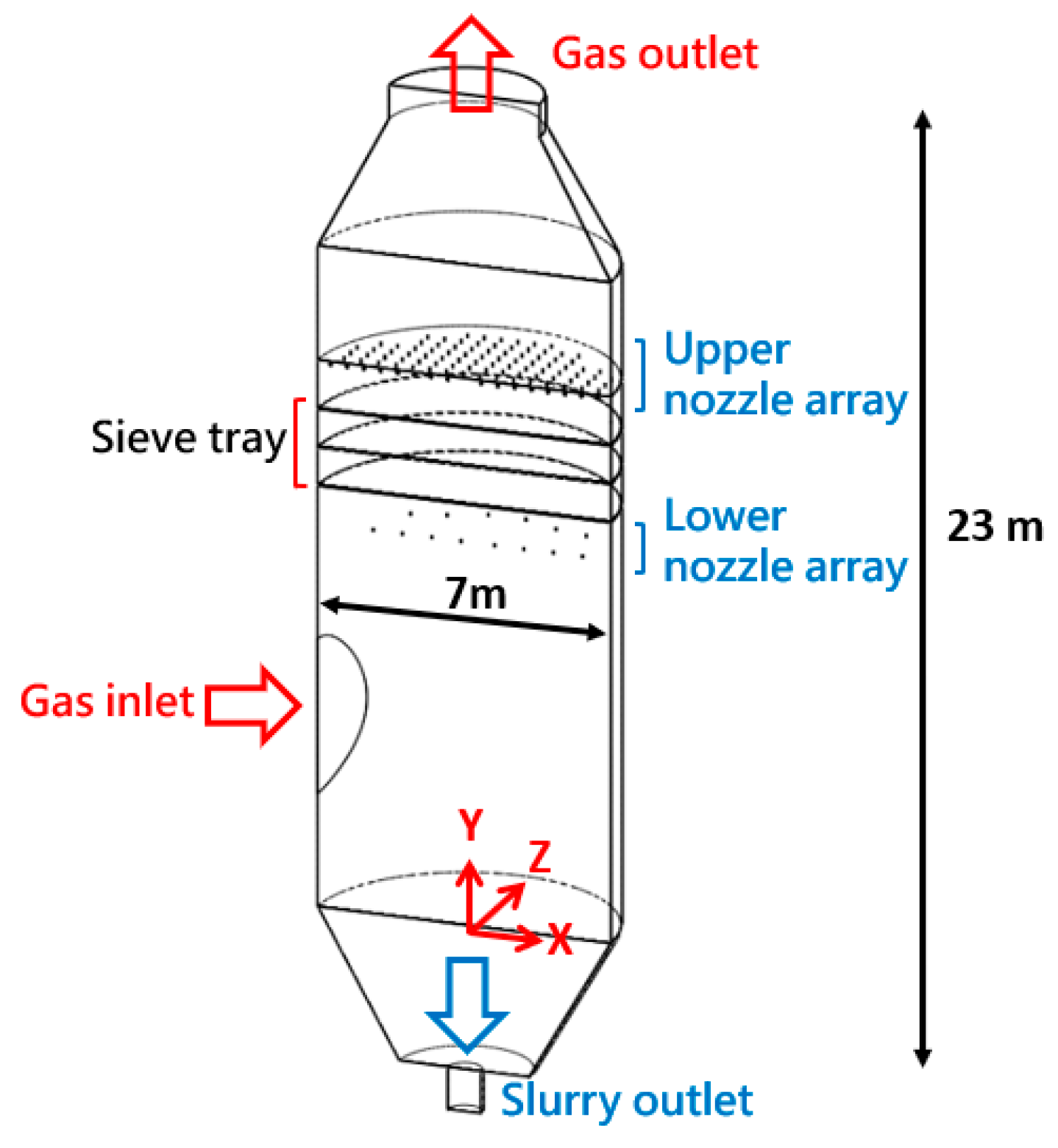

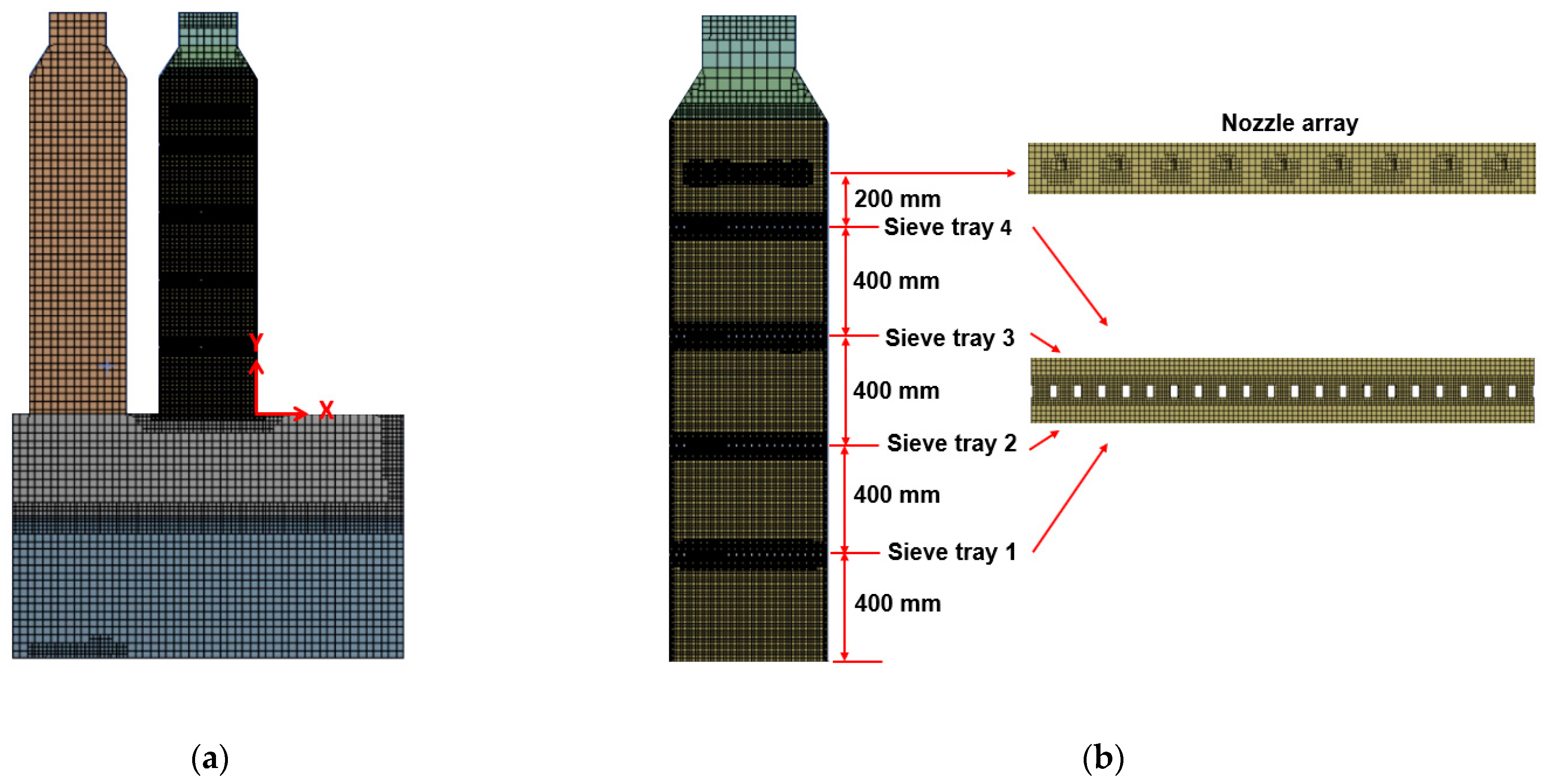

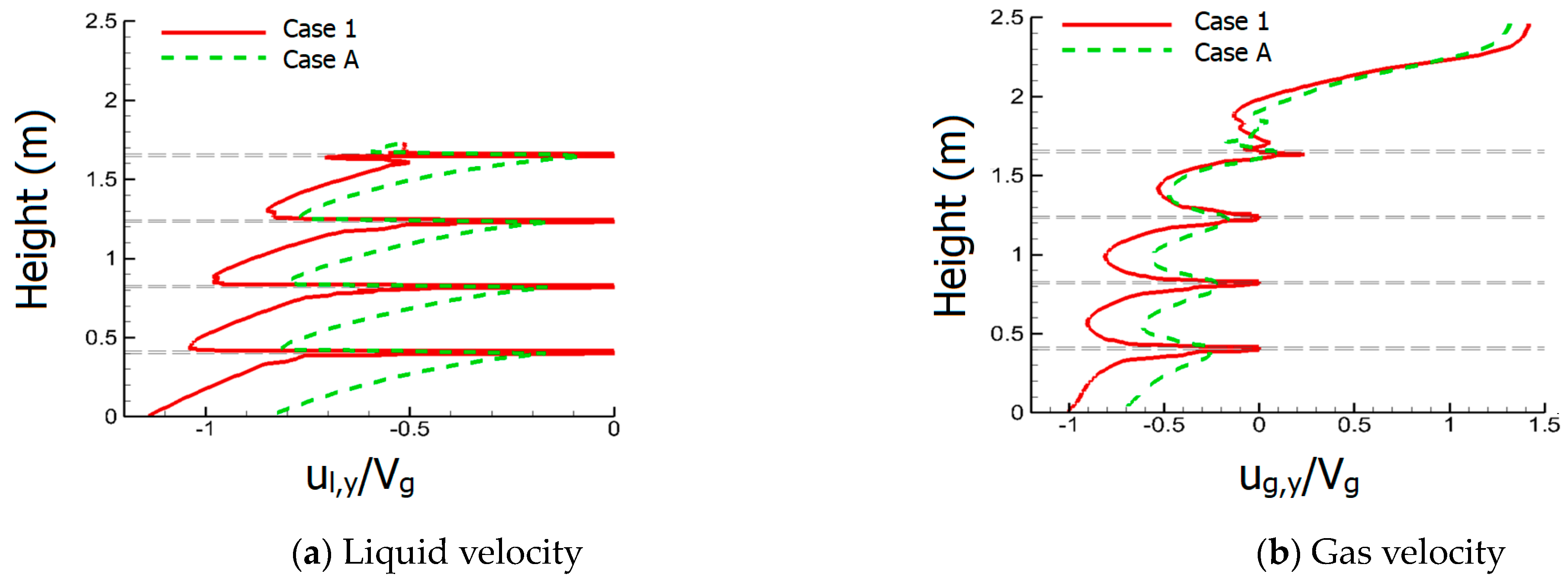
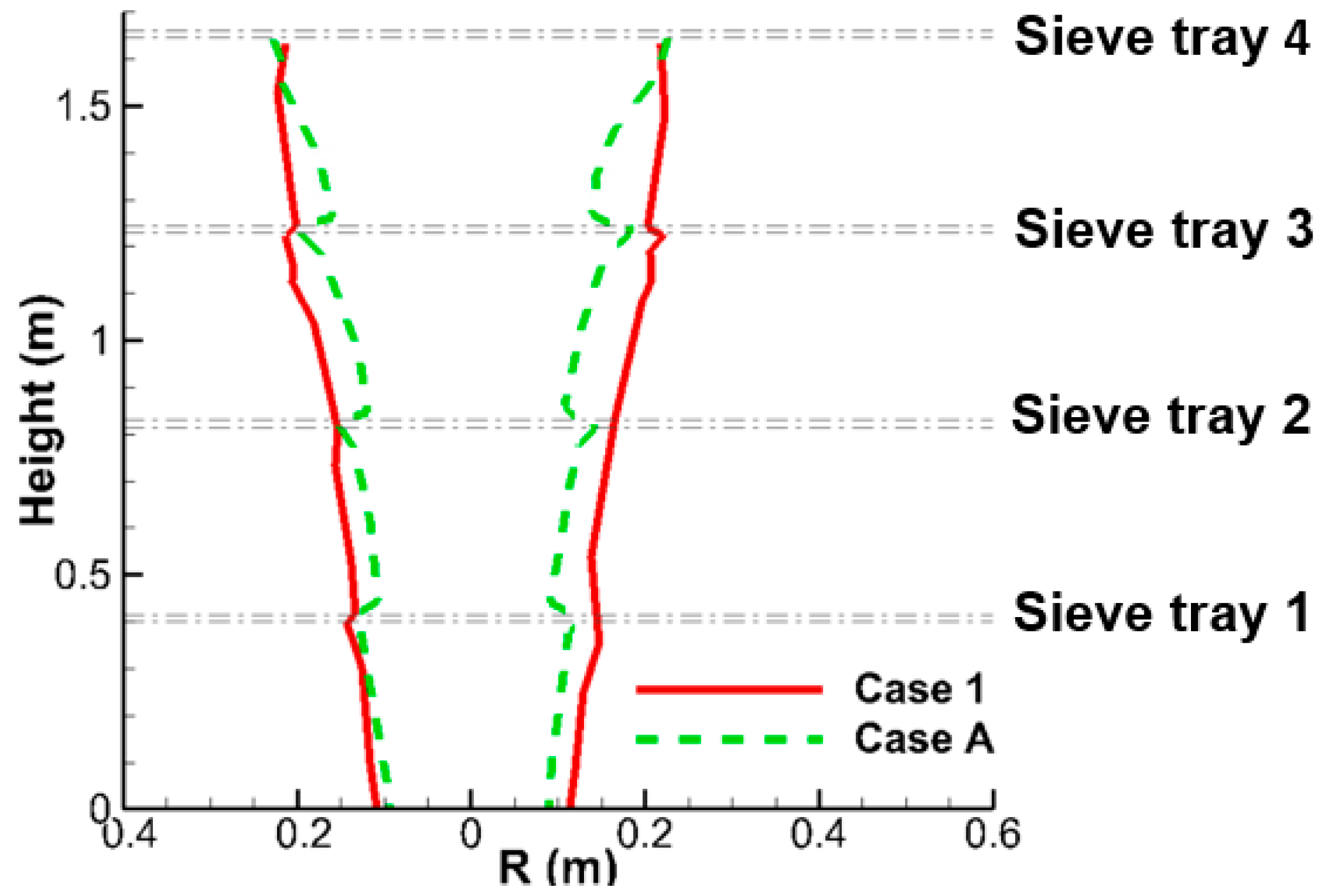



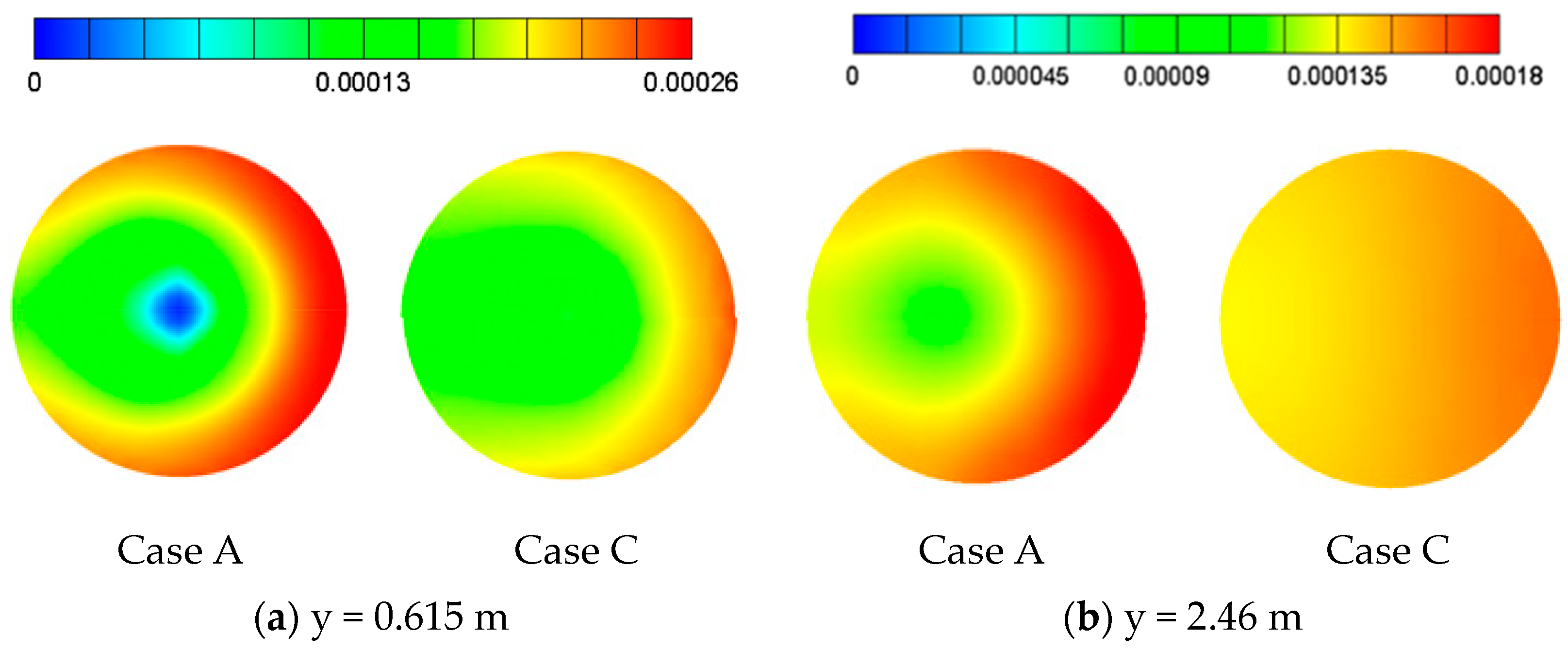
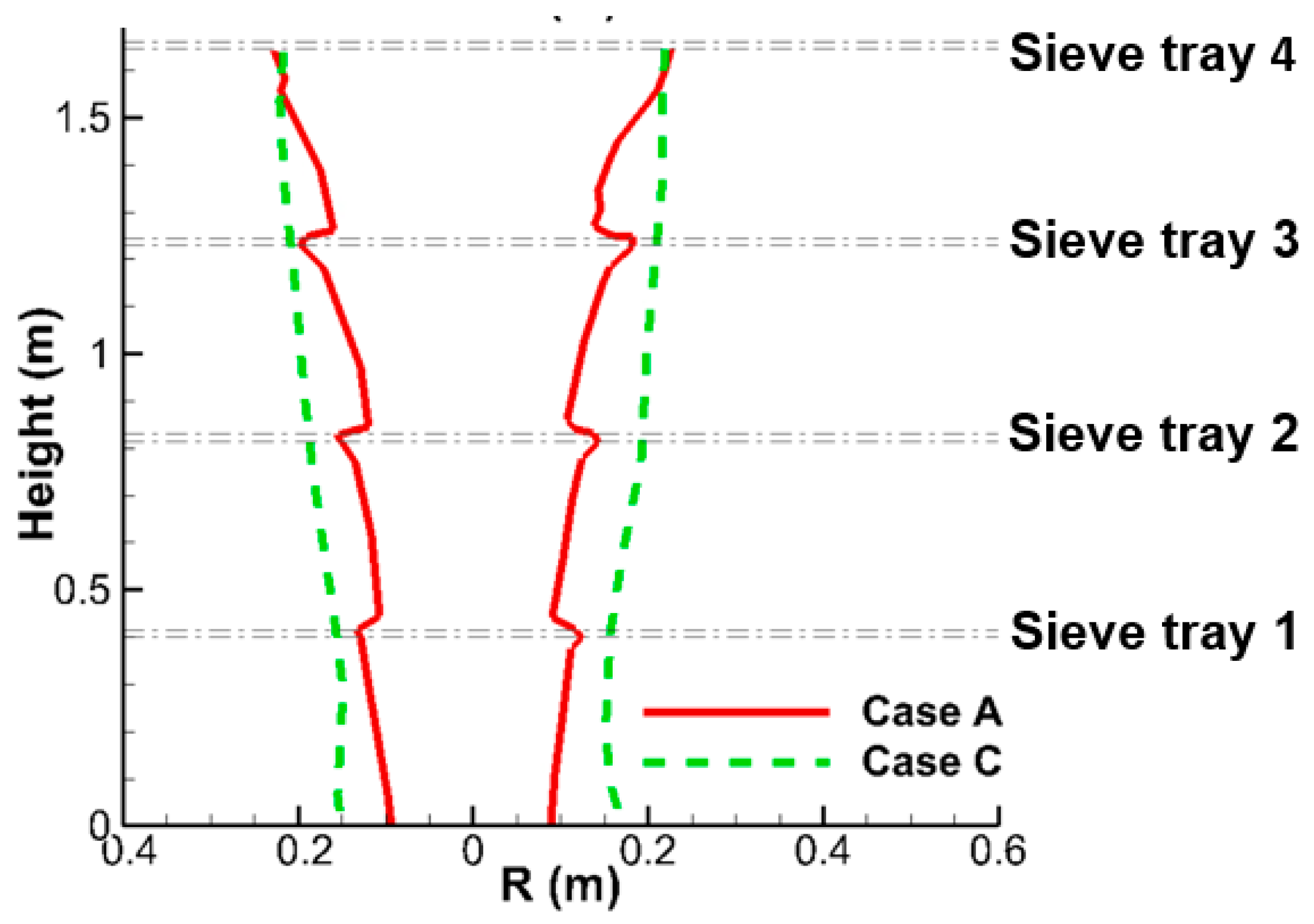
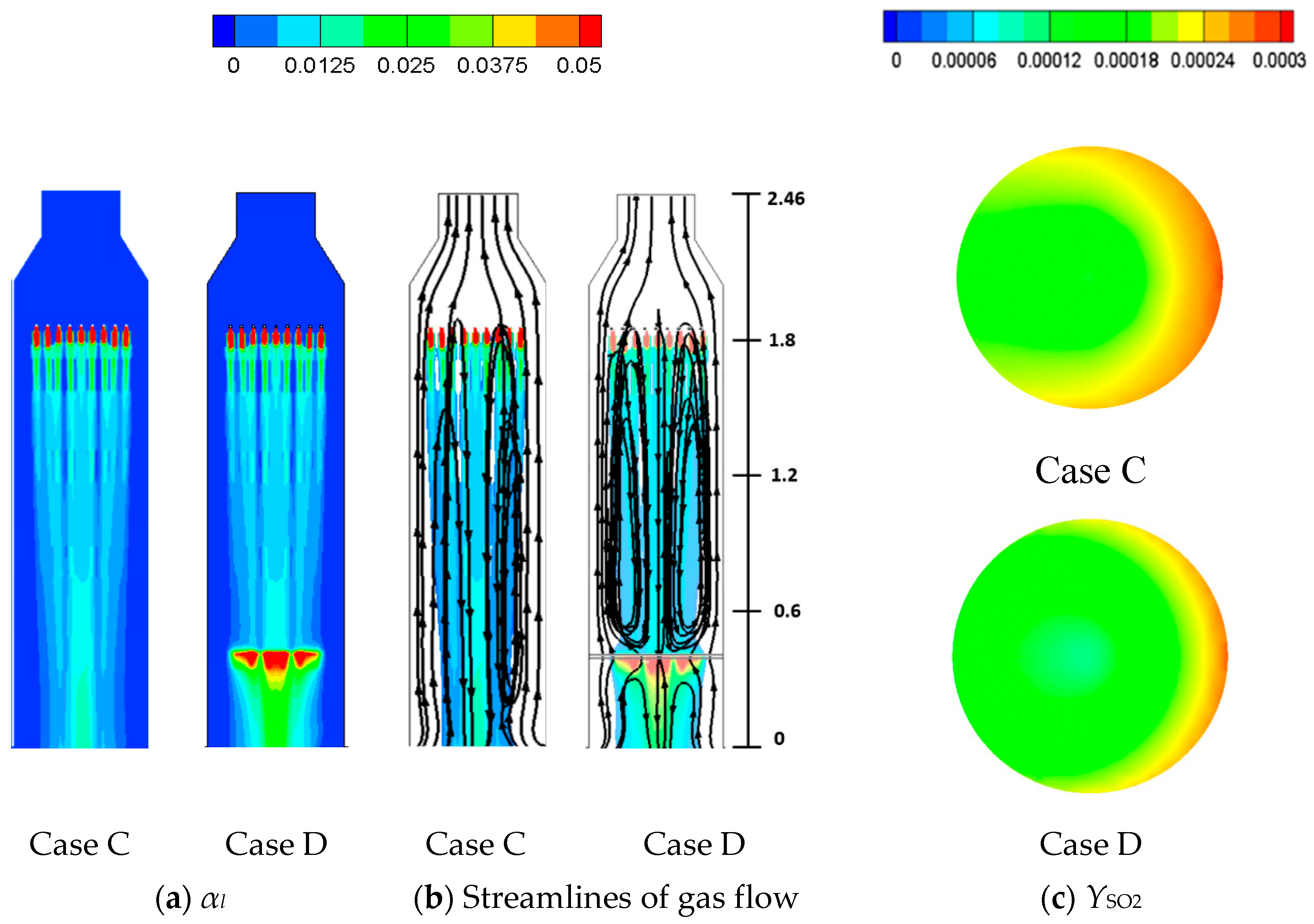
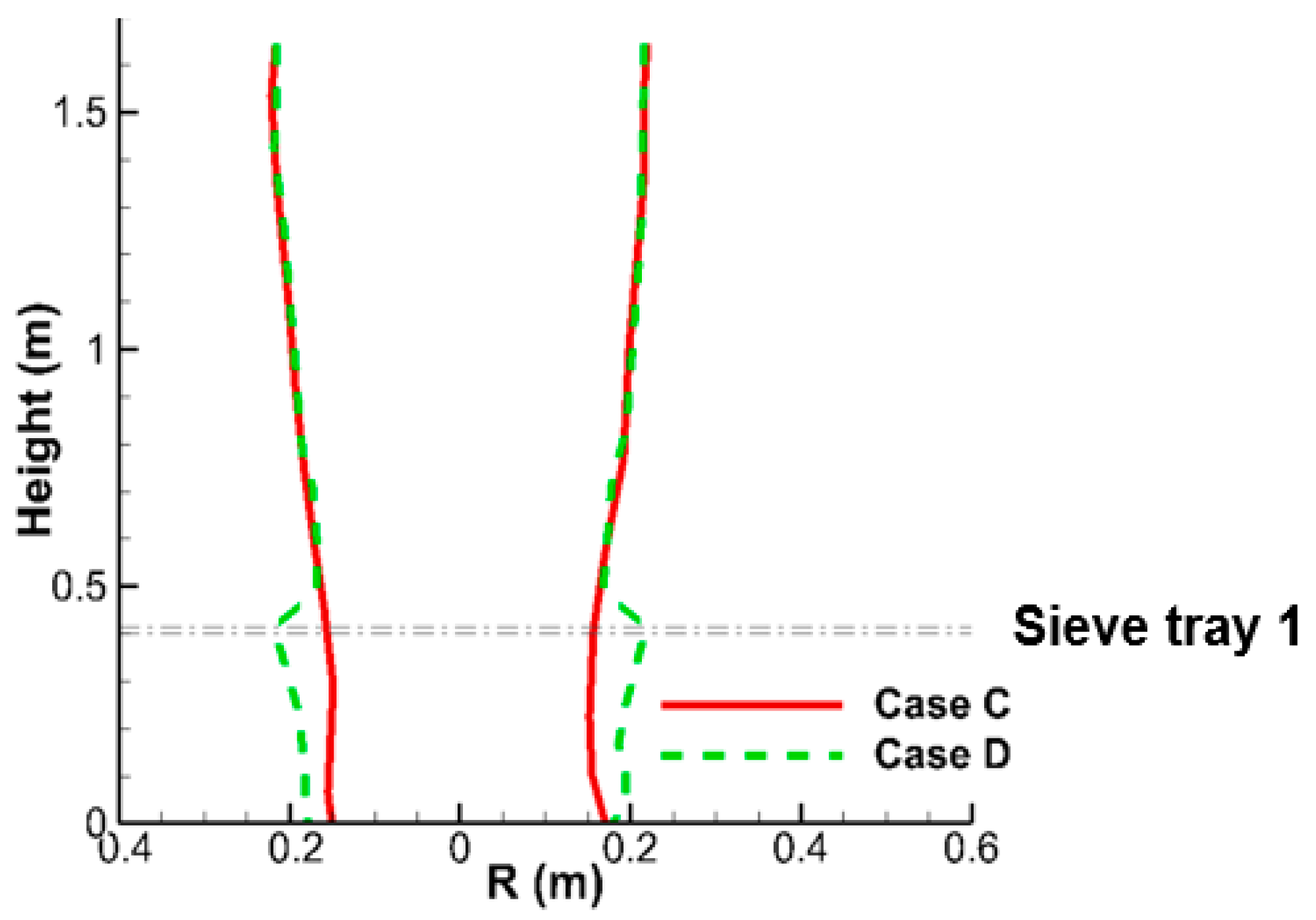
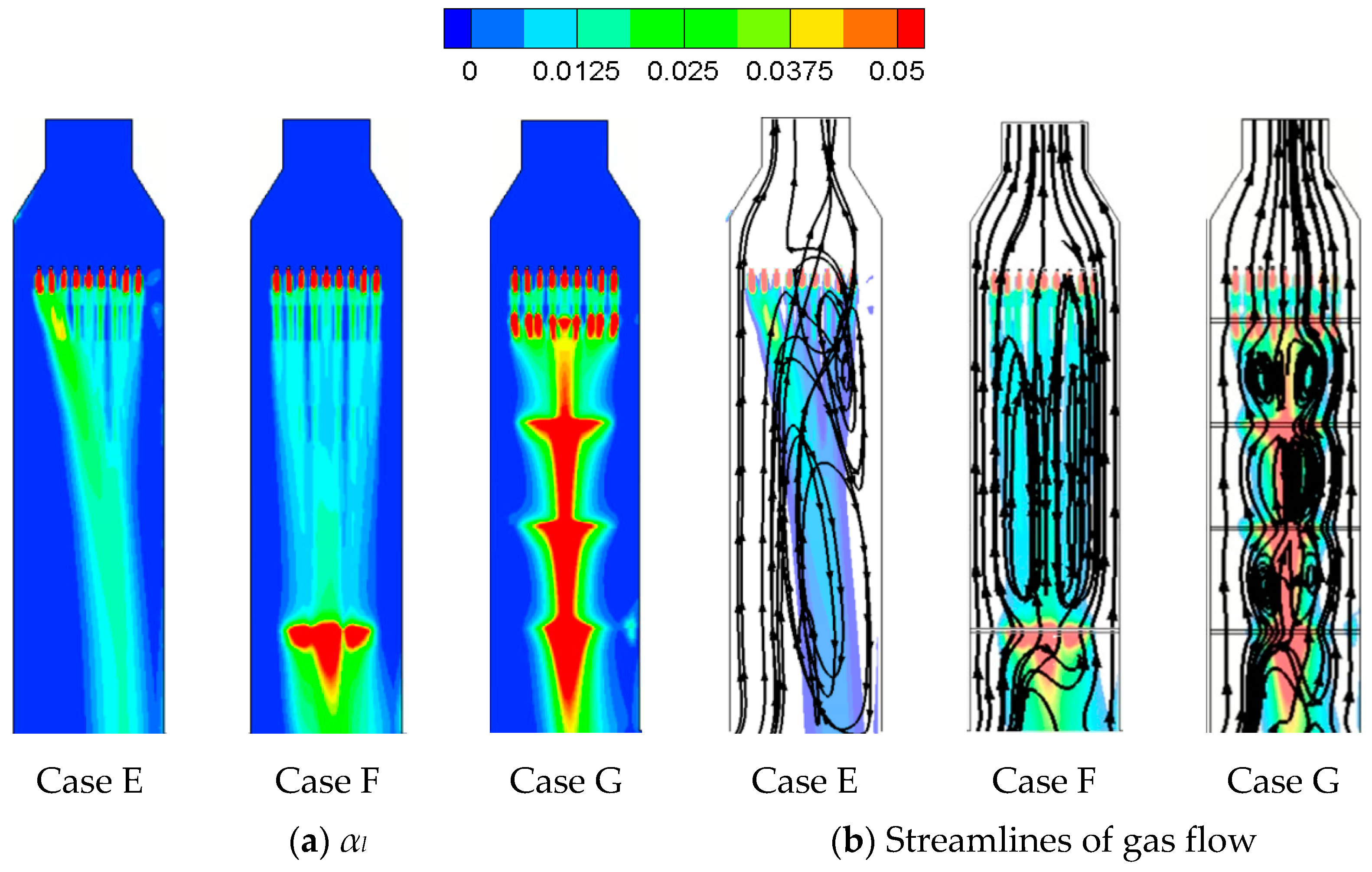

| Porosity fh | th/Dh | Reh,g | Reh,l | ||
|---|---|---|---|---|---|
| Case 1 | Case 2 | Case 1 | Case 2 | ||
| 34.3% | 0.75 | 5130 | 5130 | 860 | 573 |
| Mixture Density | Velocity | Mixture Viscosity | Reinlet | |
|---|---|---|---|---|
| Gas inlet | 1.066 kg/m3 | 3.2 m/s | 1.72 × 10−5 N∙S/m2 | 8 × 104 |
| Liquid inlets | 983 kg/m3 | 0.766 m/s | 4.68 × 10−4 N∙S/m2 | 1.6 × 104 |
| Mixture Density | Velocity | Mixture Viscosity | Reinlet | |
|---|---|---|---|---|
| Gas inlet | 1.066 kg/m3 | 3.2 m/s | 1.72 × 10−5 N∙S/m2 | 8 × 104 |
| Liquid inlets | 983 kg/m3 | 0.511 m/s | 4.68 × 10−4 N∙S/m2 | 1.07 × 104 |
| GT1 | GT2 | GT3 | |
|---|---|---|---|
| Case 1 | 62.7% | 72.6% | 60.2% |
| Case A | 66.4% | 77.7% | 67.2% |
| Exp. | 62.2% | 71.4% | 69.1% |
| GT1 | GT2 | GT3 | |
|---|---|---|---|
| Case 2 | 58.7% | 67.9% | 54.9% |
| Case B | 60.4% | 70.9% | 61.9% |
| Exp. | 48.6% | 68.4% | 57.7% |
| Case Number | Number of Trays | Q (m3/min) | Reh,g | Reh,l | Cg,y | Cl,y | Efficiency (%) |
|---|---|---|---|---|---|---|---|
| A | 4 | 24 | 5130 | 860 | 15 | 10.3 | 57.1 |
| B | 4 | 24 | 5130 | 570 | 15 | 10.5 | 51.5 |
| C | 0 | 24 | 5130 | 860 | Empty tower | 56.9 | |
| D | 1 | 24 | 5130 | 860 | 15 | 10.3 | 61.6 |
| E | 0 | 36 | 7700 | 860 | Empty tower | 48 | |
| F | 1 | 36 | 7700 | 860 | 15.7 | 10.3 | 58.8 |
| G | 4 | 36 | 7700 | 860 | 15.7 | 10.3 | 63 |
Publisher’s Note: MDPI stays neutral with regard to jurisdictional claims in published maps and institutional affiliations. |
© 2022 by the authors. Licensee MDPI, Basel, Switzerland. This article is an open access article distributed under the terms and conditions of the Creative Commons Attribution (CC BY) license (https://creativecommons.org/licenses/by/4.0/).
Share and Cite
Tseng, C.-C.; Li, C.-J. Numerical Investigations for the Two-Phase Flow Structures and Chemical Reactions within a Tray Flue Gas Desulfurization Tower by Porous Media Model. Appl. Sci. 2022, 12, 2276. https://doi.org/10.3390/app12052276
Tseng C-C, Li C-J. Numerical Investigations for the Two-Phase Flow Structures and Chemical Reactions within a Tray Flue Gas Desulfurization Tower by Porous Media Model. Applied Sciences. 2022; 12(5):2276. https://doi.org/10.3390/app12052276
Chicago/Turabian StyleTseng, Chien-Chou, and Cheng-Jui Li. 2022. "Numerical Investigations for the Two-Phase Flow Structures and Chemical Reactions within a Tray Flue Gas Desulfurization Tower by Porous Media Model" Applied Sciences 12, no. 5: 2276. https://doi.org/10.3390/app12052276
APA StyleTseng, C.-C., & Li, C.-J. (2022). Numerical Investigations for the Two-Phase Flow Structures and Chemical Reactions within a Tray Flue Gas Desulfurization Tower by Porous Media Model. Applied Sciences, 12(5), 2276. https://doi.org/10.3390/app12052276





